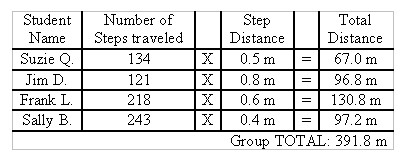Nicholas R. Perrone
During the research component, the teacher must guide the students to produce one question that they would like to analyze. Students may have a difficult time creating a focused question during their research since they will probably be looking at a great deal of information. It is the teacher’s responsibility to make sure the resulting question contains only one variable to analyze; too many variables will complicate the data collection stage and will confuse the end conclusion. For example, a group might want to research how much a couple classes walk during a month of school. They may want to analyze the number of steps they take, the distance they travel, and how many shoes get worn out. In this case, the teacher may want to step in and help the group decide to measure number of steps or distance-traveled ideas since students might not wear out their shoes in one month of school walking. The teacher should also frame an example question like, “In one month, will my class walk far enough to to reach New York City?”
In this stage, the teacher must ask guiding questions to facilitate true scientific investigation and inquiry. An example question he/she might ask would be, “In what ways will your group be able to figure out how far your class has walked during your month?” The students must brainstorm about their topic by writing down or discussing what they are interested in investigating. The next step is to list the things that could be changed or varied as well as the things that could be measured or observed. From this discourse, the problem will develop.
6
Continuing with the class walking example, the students will change the distance the class walks by encouraging the teacher to take them outside for lessons or asking other students to walk to school instead of taking the bus. This group might ask the physical education teacher for pedometers to count the number of steps each student takes each day. The group could figure out what each student’s step distance is equivalent to in feet or meters. By adding up all the steps, the group could then calculate the distance of each student by multiplying his/her step distance. Adding up all of the students would then give the group a total distance. The data table below shows an example of what these numbers might look like:

Figure 3: Walking distance data table example showing a total of nearly 400 meters of distance traveled by the combined-efforts of four students